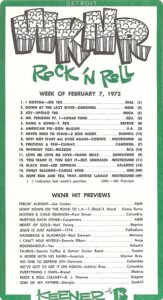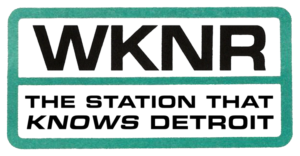 WKNR TURNED OFF ON THE DIAL. WNIC TURNS ON. THIS DAY, APRIL 25, 1972
WKNR TURNED OFF ON THE DIAL. WNIC TURNS ON. THIS DAY, APRIL 25, 1972
DETROIT (April 25, 2022) — WKNR-AM, once the dominate radio station in Detroit in the 1960s, signed-off the 1310 AM frequency for the last time on this day, April 25, 1972.

WKNR AM-FM studio facility at 150001 Michigan Ave., Dearborn.
Formerly WKMH-AM, the station made the switch to “the new Radio 13” on October 31, 1963. By early 1964, WKNR was by then the most popular radio station in Detroit and remained No. 1 in the market, still holding that status throughout the first six months through 1967.
WKNR, affectionately known as “Keener 13,” began it’s eventual slide from Detroit radio dominance in April, 1967. It was during this time WKNR saw their challenge met head-on by their other rival located across the Detroit river, CKLW.
CKLW, during that time, was totally being restructured into a formidable radio powerhouse the Canadian station would become by year’s end.

WKNR: No. 1 in 1965, according to this trade article.
RKO radio consultant Bill Drake and Paul Drew were the two people responsible for the major changes at the “Big 8.” Paul Drew, the newly-appointed program director at CKLW, patterned the same “Boss Radio” format Bill Drake and Ron Jacobs had programmed on 93 KHJ in Los Angeles. By 1965’s end, Jacob’s KHJ was by then the No. 1 radio station in L.A.
But WKNR would not easily go down without a fight. While going against the “Big 8” giant, the legendary Detroit radio station’s ratings were found inside a downward decline, all the while battling against two major fronts.
CKLW officially became the No. 1 radio station in Detroit by November, 1967, according to a Radio Response Survey published in Billboard on November 4.
CKLW, with it’s massive 50,000-watts of transmitted radio power covered 3 Canadian provinces and at times, their night-time signal spanned across 28 States. In contrast, after sundown, WKNR’s 5,000-watt signal was commonly known to be absent from the radio dial in areas east of Detroit and, more so, deficient in night-time coverage and strength.
By now, major changes had begun at WKNR both in the management and personnel level. In January of 1968, J. Michael Wilson was by then doing mornings on Keener. Dick Purtan had left WKNR for Baltimore. By the first week of April 1968, WKNR radio greats Bob Green, Jerry Goodwin, Ted Clark and Scott Regen were no longer there. Sean Conrad, Edward Alan Busch, Tony Randolph, Ron Sherwood, and Dan Henderson were to be the new voices on Keener 13.

WKNR Music Survey chart, February 07, 1972
Despite the many changes in the Detroit radio market scene at the time, WKNR’s battle for survival against CKLW and FM’s “free-form” radio would drag on for five years.
Near the end of 1971, according to a Detroit Arbitron radio rating for the period Oct./Nov., WKNR-AM had a 6:00 a.m. to 12:00 a.m. cume of 377,300 in total listenership during a given broadcast day. For WKNR, those numbers represented a reduction down to a 15 to 12 total market share. In comparison, WABX-FM ranked just under in total rank, with a cume of 330,000 during those same hours.
WKNR, who by then revamped its playlist to include some album-oriented tracks, also made much of their attempt to pull away from the “same as” CKLW all-pop music format. No longer were the top 31 songs part of the playlist rotation. Slashed in half, WKNR’s new playlist focused primarily on the top 15 hits instead, while “previewing” the other 16 songs or so for the week.

WKNR ‘TOGETHER’ logo from 1970–1971.
By late 1971 and early 1972, WKNR now was promoting itself as the new “American Rock and Roll” radio station. An obvious affront towards the dominance that was CKLW located in Windsor, Ontario.
On the 100.3 FM side, the album rock-oriented ‘underground” format that was WKNR-FM was dropped after an unsuccessful run against WABX-FM. In it’s place, Stereo Island, an easy-listening music format, now found it’s place competing against WLDM-FM in Detroit.
But the changes were not enough, and ultimately, it was not to be.
In the end, WKNR became the former on a brisk, chilly but sunny morning that was Tuesday, April 25, 1972. Just before 8:00 a.m., WKNR deejay John McCrae’s voice breaks but regains composure as he announced the inevitable —
“…This is John McCrae, I’d like to take it upon my, myself to speak on behalf of all the people who made Keener what it, was and is. You know, Pete Seeger, with a little help from his cosmic friend, wrote it much better than I could, and the Byrds sing it, much better than I, could ever say it. So this time Detroit, we’d like to thank you, for making nearly a decade — a Keener season.”

As the last few bars of the Byrd’s “Turn, Turn, Turn” began to fade, the magic that was once WKNR faded away with the song. But the memories, the events, the music, the great names, the faces and voices who crafted the Keener legacy a long time ago, remain in many a hearts and minds yet even still, to this day.
In 2002, thirty years since WKNR was last on the air, Scott Westerman and Steve Schram decided it was time someone gave WKNR it’s long due, with honors. Working together they packaged an incredibly amazing WKNR tribute site, aptly named, keener13.com.
This coming June, 2022, will mark two decades since the website’s creation. And the phenomenal story about this great Detroit radio legacy is still being told, remembered, and celebrated there on the world-wide web.
“Keener” was a radio station that went on to impact nearly a decade the many lives of a community it once served. It knew its listeners. And if only but for a short time, WKNR also was the station that, in all essence, knew the city of Detroit well by way of its prestigious award-winning news department. Informing and staying “on top of the news” during the station’s Top 40 reign here during the 1960s and early-1970s.
As WKNR legend Bob Green previously commented on Scott Westerman’s keener13.com tribute page, quote, “The WKNR experience provided some of my happiest radio memories.”
We agree.

To a generation who grew up listening to top 40 radio in Detroit during the 1960s, one may actually say many of those “happiest radio memories” we recall having heard on Keener 13 belongs to many of us today, just the same.
WKNR. Those call letters would come to embody a sensational story. Of a Detroit radio station’s historic top 40 rise to number one status — within 9 weeks — after having first signed on, October 31, 1963.
And it was a phenomenal Detroit radio story. Its legacy reverberates — again — still remembered and recalled, incredibly, to this day. Fifty years after having signed-off into Detroit radio history. April 25, 1972.
_______________
Audio digitally enhanced by Motor City Radio Flashbacks
This article was initially published on Motor City Radio Flashbacks, ten years ago, April 25, 2012. View it HERE
![]()




